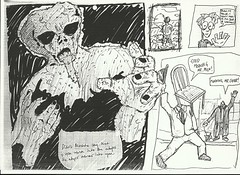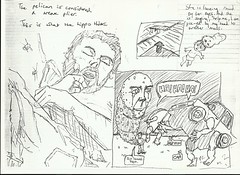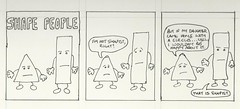
Hello humans.
Welcome to the first of new series of posts where I highlight how some specific human enhancement technologies have been developed, their real world applications, their philosophical implications and how these have played out in the pages of the superhero comic book. So if what you really want to see are pictures comic book characters who have had their heads transplanted then scroll on down, because there is going to be plenty of it.
For those of you hanging around still, here’s a bit of context. If you follow this blog then you’ll already know that my name is Dr Scott Jeffery and that my PhD thesis was on the posthuman body in superhero comics (for a condensed version of the main ideas click here). Anyway, a book that draws on the thesis but is less painfully academic (I want to say it’s ‘accessible’, but that I suppose, is a question of taste) is on its way in early 2016 (more details as and when). In the meantime, as I was editing and rewriting it occurred to me that the book doesn’t really focus on specific technologies as such. So for this new series I want to go into more detail about specific technologies and how they have been presented in posthuman theory, practice and superhero comics. Saying that, this is still the blog, so the depth and breadth of each of these articles will probably vary somewhat.
We start with one that is not mentioned at all in the book but has recently been making its rounds on the hive-mind of social media: human head transplants.
A BRIEF HISTORY OF HEAD TRANSPLANTS
Head transplantation was back in the news recently (that’s a fun sentence to write) because Italian neuroscientist Dr. Sergio Canavero, claims that the surgery could be ready as early as 2017. Canavero says the major hurdles, such as fusing the spinal cord and preventing the body’s immune system from rejecting the head, are surmountable through the use of Fusogens, plastic membranes which have been created to repair severed nerves, allowing allow the transmission of nerve impulses to the donor nervous system.It’s possible that this news will ignite a new interest in head transplants; an interest that has been somewhat dormant the last few decades. Perhaps the ‘golden age’ of head transplantation was the 1950s and 1960s, but before getting there some historical context is useful.
Scientific interest in severed heads got its first boost of interest during the French revolution, specifically the terror, which saw 16,594 people executed by guillotine, with 2,639 in Paris alone. All those decapitated heads couldn’t help but make people question whether a flicker of consciousness might remain in those disembodied skulls. Could they be kept alive in such a sate? Better yet, could they be attached to another body entirely?
As Alex Boese points out in his absurdly readable book Elephants on Acid and Other Bizarre Experiments,it was in 1857 that these questions were put to the test by Dr. Charles Edouard Brown-Sequard, who chopped a dog’s head off, drained it’s blood, then injected fresh blood into its arteries ten minutes later. This done, the severed dog’s head began to display seemingly voluntary movements in its eyes and face, until the head died again minutes later with “tremors of anguish”.
Later, in 1884, Dr. Jean-Baptiste Vincent Laborde (a member of the Society of Mutual Autopsy!) attempted the same thing with the severed head of an executed murderer named Campi, and then on another murderer’s head name Gangny (receiving it seven minutes after execution rather than the hour it took to receive Campi’s). Laborde, “connected Gangny’s carotid artery to the corresponding artery of a still-living dog, and blood was pumping through it. Laborde reported that the facial muscles contracted, as though the man were still alive, while the jaw snapped violently shut”. No sign of consciousness appeared though. Meanwhile, Laborde’s colleague Paul Loye was conducting his own research by, “erecting a guillotine in the offices of the Sorbonne and using it to decapitate hundreds of dogs [and assembling] a second-by-second chronology of the canine response to sudden head loss“. It would not be until the 1920s, when Soviet physician Sergei Brukhonenko used coagulant drugs and a heart-lung machine he called an ‘autojector’ that a severed dog’s head would be kept alive for over three hours. Though still a relatively short time Brukhonenko was able to demonstrate how his living dog heads reacted to stimuli; flinching at noises, contacting pupils when light was shone on them, and swallowing a piece of cheese, only for it to pop out of its truncated esophageal tube.

In 1960 Vladimir Demikhov he published the first monograph on transplantology, titled “Experimental transplantation of vital organs.” This influential work started transplant science as we know it today. During the 1950s Demikhov went beyond Brukhonenko and successfully transplanted dog’s head onto the bodies of other dogs, creating, in effect, two-headed dogs. This being during the Cold War, Demikhov’s work sparked a transplant arms-race between the Soviet Union and the United States. This may help to explain the internet rumour a few years back that under the auspices of Joseph Stalin, Demikhov had created a giant robot with a dog’s head. Alas, this rumour is untrue.
It wasn’t until 1970 however that the groundwork laid by Demikhov would allow American surgeon Robert White to successfully removed a monkey’s head and then reattached it to a new body. However, while the head was attached to a new body, and displayed “evidence of its awareness of the external environment“, the spinal cord remained severed so it could not control the body in any way, the new body was essentially just a blood-pump. The monkey succumbed to surgical complications after a day and a half of its presumable miserable new existence.
A BRIEFER HISTORY OF SUPER-HUMAN HEAD TRANSPLANTS
Head transplanted characters are curiously absent from superhero comics. Brain transplants and mind transfers are relatively frequent (and indeed mind-uploading will receive its own entry in this series), however, full head transplants are less common. Among the few disembodied heads to control a robotic body is the little known Marvel villain the Faceless One. However, it turns out that the Faceless One is actually a member of the alien race the Kt’kn, who appear to take the form of small, golden orbs on spider-legs, so whether this counts as a head transplant when his head is, in fact, his body, is debatable.

Closer to the mark is a character known simply as The Head, who appeared way back in Young Allies #12, in Spring 1944. An agent of the Imperial Japanese Army whose body was crushed in an accident, The Head’s, um, head, was kept alive using a life support system which was layer incorporated into a miniature hover craft! You can see more of The Head here.
Head transplantation also plays an important role in the life of Batman villain Mister freeze, at least as it played out in the animated series The New Batman Adventures. In the episode Cold Comfort when it is revealed that Freeze’s body has deteriorated to such a point that he was only able to save his head. When not attached to an artificial body Freeze’s head prances about on a nifty little spider-like contraption. Interestingly, while the animated depictions of Freeze generally painted him as a somewhat sympathetic character, in Cold Comfort he simply seeks to cause chaos; his new antipathy towards the world a direct result of the pain cause by his bodiless existence. Freeze’s head later turns up in the Batman Beyond episode Meltdown. Unfortunately that episode doesn’t quite count for this post as rather than a head-transplant, Mister Freeze’s mind is transferred into a new, cloned body. Even so, spider-head Mister Freeze must be fairly popular because you can but an action figure of him if you want.
Meanwhile, over in the Marvel Universe, the history of human and primate head transplants converge in the form of Dr Arthur Nagan AKA Gorrila-Man. Gorilla-Man first appeared in 1954 as a story in Mystery Tales. Nagan was a gifted surgeon who was performing removing ‘superior’ organs from gorillas to transplant into humans, meanwhile transplanting the inferior human organs into the gorilla. One escaped, informed his fellow Gorillas of Nagan’s plan, so the gorillas got together and transplanted Nagan’s head on to a gorilla’s body. No, really. That was him emerging from the bushes right at the start of this post, and here he is more recently ( I love how we still know Gorilla-Man is a scientist because he still wears his lab-coat):
Gorilla-Man is leader of the Headmen, who are without question the greatest super-villain team in the history of comics. Certainly the most head-centric anyway. Take Gorilla-man’s team-mate Chondu the Mystic. The erstwhile Harvey Schlemerman was lecturer in yoga (!) whose knowledge of the art had gifted him with special powers. Falling in with Nagan, he attempted to infiltrate superhero team The Defenders by allowing the scientist to transplant his brain into the body of Nighthawk. His mind is later displaced and Dr. Strange places it instead into the brain of a baby deer. When his mind is eventually returned to his own brain Gorilla-Man takes the opportunity to place it in a new body complete with bat wings, clawed feet, and EIGHT LAMPRIES FOR ARMS! Complete with bonus unicorn’s horn and forked tongue. As you can see below, he’s not best pleased about these improvements.

Chondu’s head has since been transplanted by Nagan on to a variety other host bodies, including a nifty robotic arachnid affair and an artificial replica of She-Hulk’s body. Which is AMAZING.
Chondu isn’t the only member of the Headmen to have Nagan muck about with their cranium. Fellow team-member Ruby Thursday had her head replaced with, to quote from the Marvel wiki:
a mass of “organic circuitry,” a malleable red plastic that can mimic all the proper functions of a human head (seeing, hearing, speaking and presumably breathing and eating).
Among the powers made available to Ruby by her spherical, red plastic head are the ability to extrude up to eight elongated tentacles from her head, each of which can form sharp and blunt weapons. More than that, “she can emit a huge sticky blanket or up to twenty projectiles at a time from her head. Her head immediately replenishes its lost mass, presumably from an extradimensional source“. Her head can also can also separate from her body, and fly, controlling the body remotely, as well as being able to explode and reform!
In comparison to Gorilla-Man, Chondu and Ruby Thursday, the Headmen’s fourth member Jerold Morgan, AKA Shrunken Bones, is a disappointing specimen. He can’t even claim any real head trauma either; he created a shrinking gas that shrunk his bones but not his body. But, you know, he’s weird-looking and a pally with Nagan, so he gets to be a Headman anyway.

If there is anything to learn from this discussion it is that sentient disembodied heads love to walk around on spider-legs. Also, that full head transplants are surprisingly uncommon in comic books, despite their obvious visual possibilities. Although head transplants remain rare in comic books it is intriguing to note that at least one such real-life experiment found its way into comic book form via Charlton Comics’ Marvels of Science from 1946. And so we end by returning to the beginning with this oddly moving depiction of Sergei Brukhonenko’s severed dog’s heads.
















April 20th, 2015 at 00:55
I imagine all the members of the Society of Mutual Autopsy are now deceased, but what a fun concept! As far as human head transplants becoming a reality, I scoff, but some people will do anything to get ahead. (Sorry, but I couldn’t resist)